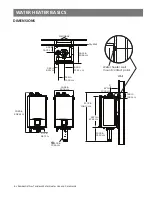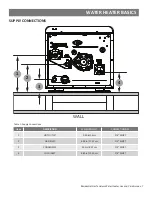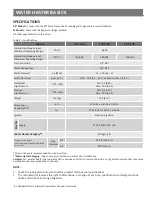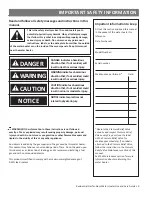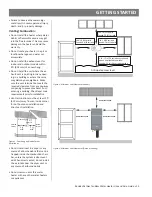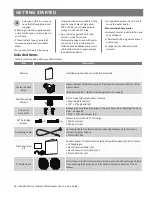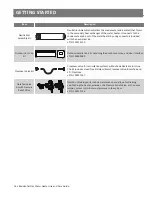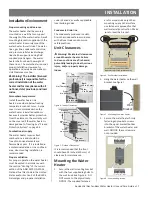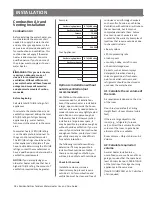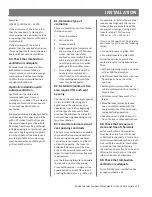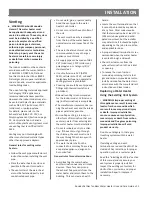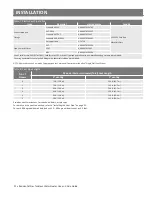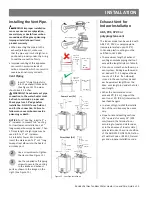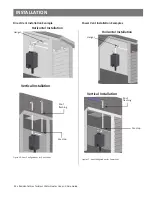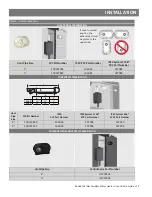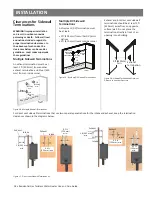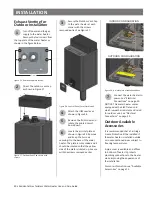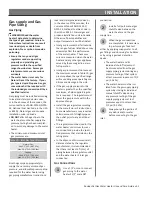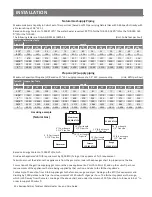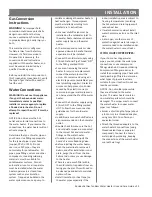
18 • Residen al Gas Tankless Water Heater Use and Care Guide
INSTALLATION
Combus on Air and
Ven ng Installa on
Combus on Air
Before installing the water heater, you
must determine the amount of air
needed to supply this water heater
and any other gas appliances in the
same area and provide adequate air
for combus on and ven la on. This
sec on does not apply if the water
heater is direct vented. Consult a
quali
fi
ed person if you’re unsure of
the proper way to supply air to your
water heater.
WARNING! This gas water heater
requires an adequate source of
clean air for combus on and
ven la on. Without su
ffi
cient air,
your water heater will have frequent
outages and may emit excessive
and abnormal amounts of carbon
monoxide.
Before beginning:
Calculate total BTU/HR ra ng of all
appliances.
To calculate the combus on air and
ven la on required, add up the total
BTU/HR ra ngs of all gas burning
appliances (e.g., water heaters,
furnaces, clothes dryers) in the same
area.
Your water heater’s BTU/HR ra ng
is on the data plate, located next to
the gas control valve/thermostat.
The BTU/HR ra ngs should be on the
other appliances’ data plates. If you
have trouble determining the BTU/HR
ra ngs, contact the manufacturer or
have a quali
fi
ed person determine the
ven la on requirements.
NOTICE:
If you are replacing your
old water heater with one that has a
higher BTU/HR ra ng, the amount of
ven la on required may be greater.
Example:
Gas Burning Appliance
BTU/HR Ra ng
Gas Water Heater
199,000
Furnace
75,000
Dryer
20,000
Total
294,000
Your Appliances:
Gas Burning Appliance
BTU/HR Ra ng
Gas Water Heater
Total
Op on A: Installa on without
outside ven la on (not
recommended)
Ven la on with outdoor air is
recommended for all installa ons.
Even if the water heater is installed in
a large, open room inside the house,
outdoor air is usually needed because
modern homes are very ghtly sealed
and o en do not supply enough air
to the water heater. However, when
installed in a large indoor space, it
may be possible to provide enough air
without outside ven la on. If you are
unsure if your installa on loca on has
enough ven la on, contact your local
gas u lity company or code o
ffi
cials
for a safety inspec on.
The following instruc ons will help
determine if it may be possible to
install without outside ven la on. If
there is not enough ven la on, you
will need to ven late with outside air.
Check for Chemicals:
Installa ons where corrosive
chemicals may be present require
outside air. Air for combus on and
ven la on must be clean and free of
corrosive or acid-forming chemicals
such as sulfur,
fl
uorine, and chlorine.
Ven la on with outside air will reduce
these chemicals, but it may not
completely eliminate them. Failure
due to corrosive chemicals is not
covered by the warranty. Examples of
loca ons that require outside air due
to chemicals include:
• Beauty salons
• Photo processing labs
• Indoor pools
• Laundry, hobby, or cra rooms
• Chemical storage areas
Products such as aerosol sprays,
detergents, bleaches, cleaning
solvents, gasoline, air fresheners,
paint and varnish removers, and
refrigerants should not be stored or
used near the water heater.
A1: Calculate the air volume of
the room
Air requirements depend on the size
of the room.
Floor Area (square feet) x Ceiling
Height (feet) = Room Volume (cubic
feet)
If there are large objects in the
room (e.g., refrigerator, furnace,
car), subtract their volume from the
volume of the room to get a be er
es mate of the air available.
Room Volume – Object Volume = Air
Volume
A2: Calculate required air
volume
A water heater installed in an
uncon
fi
ned space, such as an a c or
garage, requires that the space be at
least 50 cubic feet per 1,000 BTU/HR
of the total input for all gas burning
appliances in the same area.
[Total BTU/HR/1000] x 50 = Cubic feet
of air required.



